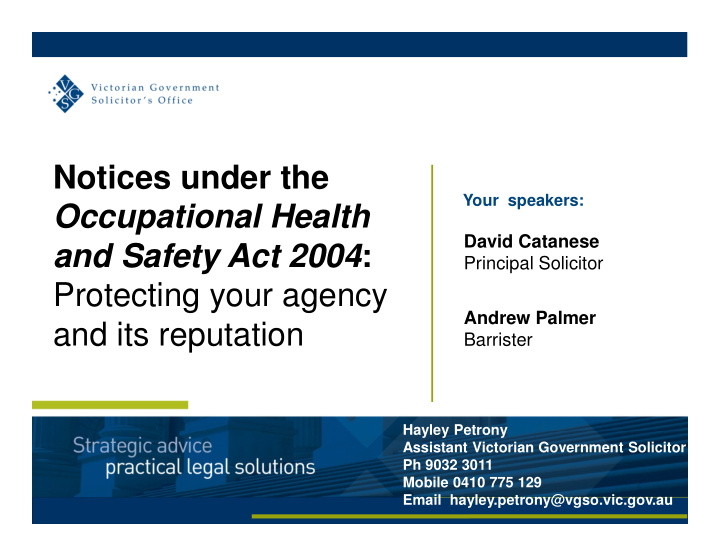



Notices under the Your speakers: Occupational Health David Catanese and Safety Act 2004 : Principal Solicitor Protecting your agency Andrew Palmer and its reputation Barrister Hayley Petrony Assistant Victorian Government Solicitor Ph 9032 3011 Mobile 0410 775 129 Email hayley.petrony@vgso.vic.gov.au
Speakers • David Catanese , Principal Solicitor, VGSO – The legislative scheme for notices under the Occupational Health and Safety Act 2004 • Andrew Palmer , Barrister – Key considerations when issued with a Notice
Occupational Health and Safety Act 2004 The OHS Act applies to the State of Victoria as an employer: • Section 6(1) - the OHS Act binds the Crown • Section 6(2) - the Crown is deemed to be a body corporate for the purposes of the OHS Act and its Regulations
OHS Act continued Section 21 - provide and maintain a safe working environment for employees Section 23 - prevent persons other than employees from being exposed to health and safety risks arising from the conduct of the employer’s undertaking Section 144 - direct liability of officers for failure to take reasonable care
OHS Act continued • Reasonable practicability test • Offences under the OHS Act are criminal offences • Maximum penalties: – Body corporate - $1,300,000 – Individual - $260,000
WorkSafe The Victorian WorkCover Authority t/a WorkSafe Victoria “WorkSafe Victoria, the VWA's occupational health and safety arm, takes the lead role in the promotion and enforcement of health and safety in Victorian workplaces. WorkSafe has a team of more than 450 field officers, investigators, work-site technical experts and support staff spread throughout a network of city, suburban and regional offices. The WorkSafe team is responsible for improving workplace safety through implementing the organisation's comprehensive constructive compliance strategy which focuses on information and education, incentives, enforcement, investigations, prosecutions and penalties.”
WorkSafe • Powers to: – Attend worksites – Compel production of documents – Seize evidence – Require persons to answer questions – Issue various Notices… • Investigation � prosecution
Notices under the OHS Act • Non-Disturbance Notices (s 110) • Improvement Notices (s 111) • Prohibition Notices (s 112) • Provisional Improvement Notices (s 60)
Non-Disturbance Notices To stop the use of plant, equipment, etc., or to prevent the disturbance of any plant or equipment or a scene at a workplace: " if an inspector reasonably believes that it is necessary to do so to facilitate the performance of his or her functions or exercise of his or her powers under this Act or the regulations in relation to the place or any plant, substance or other thing at the place. "
Improvement Notices If an inspector reasonably believes that a person: (a) is contravening a provision of the OHS Act or the regulations; or (b) has contravened such a provision in circumstances that make it likely that the contravention will continue or be repeated, the inspector may issue to the person an improvement notice requiring the person to remedy the contravention or likely contravention or the matters or activities causing the contravention or likely contravention.
Improvement Notices continued • The accumulation of Improvement Notices may lead to an inference being drawn about the standard of safety at your workplace • Compliance with an Improvement Notice may be seen as an admission of a contravention of the OHS Act
Prohibition Notices If an inspector reasonably believes that: (a) an activity is occurring at a workplace that involves or will involve an immediate risk to the health or safety of a person; or (b) an activity may occur at a workplace that, if it occurs, will involve an immediate risk to the health or safety of a person, the inspector may issue to a person who has control over the activity [usually the employer] a prohibition notice prohibiting the carrying on of the activity, or the carrying on of the activity in a specified way, until an inspector has certified in writing that the matters that give or will give rise to the risk have been remedied
Provisional Improvement Notices If a health and safety representative believes on reasonable grounds that a person, usually the employer: (a) is contravening a provision of the OHS Act; or (b) has contravened a provision of the OHS Act in circumstances where that contravention will continue or be repeated, then the health and safety representative may issue a PIN requiring the employer to remedy the contravention or the matters or activities causing the contravention
Review of Notices • Internal review (s 128) • External review (s 129)
Key Messages 1. Address the safety risks 2. Discuss the issues with the Inspector 3. Seek legal advice about challenging the Notice 4. Avoid creating unnecessary documents 5. Don't let Notices accumulate
Key Messages 6. Don't assume that a prosecution won’t follow 7. Assume that all Notices will be used in later legal proceedings 8. Ensure that compliance with a Notice is confirmed
Andrew Palmer Key considerations when issued with a Notice
Key considerations on receipt of a Notice 1. Do you understand the Notice? 2. Do you agree that there is a problem? 3. Do you agree with the solution suggested by WorkSafe? 4. Do you think there is a better solution? 5. Do you have other reasons for wanting to have the Notice withdrawn?
Recommend
More recommend